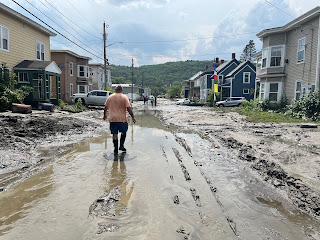Weathering the Storms: How to Stay Prepared for Flooding
By Dan Dowling, Regional Communications Manager
As a meteorologist and a Vermonter for 25 years, I’ve seen a lot of extreme weather. I have had a front-row seat to some of the biggest snowstorms, heaviest rainfall events and hottest stretches of weather that Vermont has experienced over the past few decades.
In 2011, Tropical Storm Irene dropped historic amounts of rain over central Vermont, creating some of the worst flooding the state had seen in decades. Roads were washed away and hundreds of homes were either damaged or destroyed.
Just 12 years later, flooding has returned. A slow-moving weather pattern, paired with humid, tropical air, brought rainfall that rivaled or exceeded that of Tropical Storm Irene. Once again, many Vermonters are faced with the task of recovery and rebuilding.Dr. Janel Hanrahan, a research scientist at RTI International, explains why a warmer planet is leading to more weather extremes. “When you have a warmer atmosphere, you have more capacity for the water vapor. There’s an endless supply of water, because 70 percent of the planet is ocean,” says Hanrahan. “So if the atmosphere can take up more water vapor, it will, and it has, and turns into an amplified hydrologic cycle. That means when it rains, it really rains. When it’s dry, it’s really dry. Everything is just exaggerated from what it was previously.”
When weather patterns persist for weeks at a time, as we’ve seen this summer, they lead to numerous heavy rainfall events over the same area. The ground becomes saturated, and when the next storm arrives, there is nowhere for the rain to go, resulting in flooding.
Scott Whittier, a meteorologist from the National Weather Service in Burlington, Vermont, describes the increase in extreme weather over New England, “The data shows that we’re having more of these intense rainfall events, but between those intense rainfall events you’ve got longer dry periods, which we’ve seen the past two or three years, which includes this year up until this event.”
Hanrahan and Whitter agree that we’re seeing an increase in intense rainfall events over New England, and that we can expect more extreme weather events in the years ahead.
Since 2019, the Red Cross has seen a six-fold increase in the annual number of disasters causing $1 billion or more in damage, compared to 40 years ago. This relentless pace of severe disasters has created more ongoing emergency needs — including for families who have been displaced year after year by extreme weather.
Several Red Cross responders attended a town hall meeting hosted by FEMA to explain the process for applying for aid in the wake of the federal disaster declaration. The audience was packed with Barre and Orange county residents whose homes had been damaged by flooding in this storm.“I’m homeless at 75 years old,” said Richard Corey, whose Vine Street home has flooded five times since Tropical Storm Irene hit in 2011. “My future is a big question mark.”
Even as the American Red Cross delivers disaster relief such as food and shelter, we also think about the future and plan for how to help impacted communities and families recover in the months and years ahead. Prepare for disasters in advance by putting together a kit, making a plan with your family and figuring out how you will stay informed when an emergency strikes.
“Get a kit, make a plan, be informed”
Your emergency kit should contain food, water and other basic supplies to last at least three days for each family member. Also, don’t forget to include essential medications, copies of important documents and special items for children and pets. You can slowly build your kit by buying one extra item at a time, but make sure to check it regularly to make sure everything is up to date.
Plan what to do in case you are separated from your family during an emergency and what to do if you have to evacuate. Make sure to coordinate your plan with your child’s school, your work and your community’s emergency plans. You can download the free Red Cross Emergency app to get lifesaving information on your phone by searching “American Red Cross” in your app store or visiting redcross.org/apps.
Include pets in your emergency plans. Remember, if you need to evacuate, so does your pet. It’s important to plan in advance to know which pet-friendly hotels are in your area and where your pets can stay in an emergency situation.
If your area is expecting flooding, stay off the roads and away from floodwaters. If you are told to evacuate or must drive for another reason, avoid flooded roadways. If you are caught on a flooded road and waters are rising around you, quickly get of out the car, move to higher ground and stay there. Most cars can be swept away by less than two feet of moving water.If power lines are down, don’t step in any puddles or standing water. Follow evacuation orders and don’t return home until you are told it is safe to do so. Keep children and pets away from hazardous sites and floodwaters.
Be cautious when cleaning up your home and wear protective clothing, including rubber gloves and boots. Throw out items that absorb water and cannot be disinfected and dispose of all food, drinks and medications. If the weather is dry, open windows and doors to ventilate and dry out your home.
Emergencies are more common than you may think. In fact, the Red Cross responds to a disaster every eight minutes, and our volunteers are ready 24/7 to help those in need. Your donation to American Red Cross Disaster Relief helps communities prepare for, respond to and recover from disasters big and small. Visit redcross.org to donate. Every single donation makes a difference in someone’s life.





Comments
Post a Comment